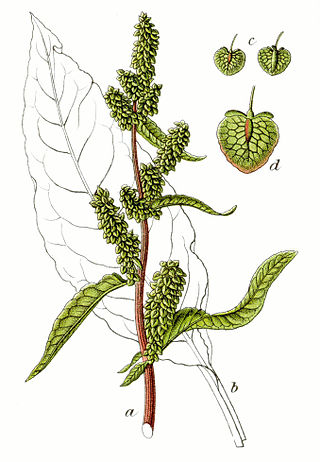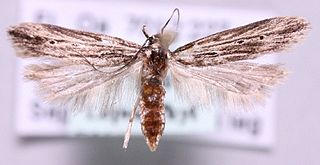
Sorrel, also called common sorrel or garden sorrel, is a perennial herbaceous plant in the family Polygonaceae. Other names for sorrel include spinach dock and narrow-leaved dock.

The docks and sorrels, genus Rumex, are a genus of about 200 species of annual, biennial, and perennial herbs in the buckwheat family, Polygonaceae. Members of this genus are very common perennial herbs with a native almost worldwide distribution, and introduced species growing in the few places where the genus is not native.

Rumex obtusifolius, commonly known as bitter dock, broad-leaved dock, bluntleaf dock, dock leaf, dockens or butter dock, is a perennial plant in the family Polygonaceae. It is native to Europe, but is found on all temperate continents. It is a highly invasive species in some zones, resulting from its abundant seed dispersal, adaptability to reproduce, aggressive roots, ability to tolerate extreme climates, and hardiness.

The large copper is a butterfly of the family Lycaenidae. L. dispar has been commonly arranged into three subspecies: L. dispar dispar, (single-brooded) which was commonly found in England, but is now extinct, L. d. batavus, (single-brooded) can be found in the Netherlands and has been reintroduced into the United Kingdom, and lastly, L. d. rutilus, (double-brooded) which is widespread across central and southern Europe. The latter has been declining in many European countries, due to habitat loss. Currently L. dispar is in severe decline in northwest Europe, but expanding in central and northern Europe.

Rumex acetosella, commonly known as red sorrel, sheep's sorrel, field sorrel and sour weed, is a species of flowering plant in the buckwheat family Polygonaceae. Native to Eurasia and the British Isles, the plant and its subspecies are common perennial weeds. It has green arrowhead-shaped leaves and red-tinted deeply ridged stems, and it sprouts from an aggressive and spreading rhizome. The flowers emerge from a tall, upright stem. Female flowers are maroon in color.

Rumex hymenosepalus, commonly known as canaigre, canaigre dock, ganagra, wild rhubarb, Arizona dock, and tanner's dock, is a perennial flowering plant which is native to the North American deserts in the southwestern United States and northern Mexico. It is a common food plant of the ruddy copper larvae.

Monochroa is a genus of moths in the family Gelechiidae.

Rumex graminifolius, common name grassleaf sorrel, is a species of the genus Rumex and the knotweed family Polygonaceae.

Rumex salicifolius is a species of flowering perennial plant in the knotweed family known by the common names willow dock and willow-leaved dock. It is native to much of western North America, and more specifically, in southern and central parts of California, and some parts of Arizona and Nevada. It can also be found in parts of Europe as an introduced species and a roadside weed. It is an extremely variable plant which is generally divided into many varieties, some of which may actually be specimens of other species.

Monochroa cytisella is a moth of the family Gelechiidae and found in most of Europe. The larva feed in the stems of bracken causing a slight gall.
Monochroa suffusella, the notch wing neb, is a moth of the family Gelechiidae. It is found from Fennoscandia to the Pyrenees and Alps and from Ireland to Romania. In the east, the range extends to Japan. The habitat consists of bogs, fens, swamps and salt-marshes.

Monochroa sepicolella is a moth of the family Gelechiidae. It is found from central and northern Europe to the Ural Mountains, the Caucasus and southern Siberia.

Monochroa conspersella is a moth of the family Gelechiidae. In Europe, it is found from the Alps to the north. In the east, the range extends to the southern Ural and the Middle Volga, as well as Japan.

Monochroa tetragonella, the saltern neb, is a moth of the family Gelechiidae. It is found in Scandinavia, the Baltic region, Great Britain, the Netherlands and Russia. The habitat consists of saltmarshes.

Monochroa elongella, the Pembroke neb, is a moth of the family Gelechiidae. It is widely distributed throughout Europe. Outside of Europe, it is found in southern Siberia. The habitat consists of coastal sand-dunes and chalk downland.

Monochroa divisella, the scarce marsh neb, is a moth of the family Gelechiidae. It is found in Denmark, Latvia, Germany, the Netherlands, Belgium, Great Britain, the Czech Republic, Hungary, Bulgaria and France. Outside of Europe, it is known from Korea, the Russian Far East and Japan. The habitat consists of fens, marshes, river-banks and other damp areas.

Monochroa palustrellus, the wainscot neb, is a moth of the family Gelechiidae. It is found in from western, central and northern Europe to the Ural Mountains and southern Siberia. The habitat consists of waste ground, dry pastures and sand-dunes.

Monochroa tenebrella, the common plain neb, is a moth of the family Gelechiidae. It was described by Jacob Hübner in 1817. It is found in most of Europe. The habitat consists of open grassy areas and heathland.
Monochroa rebeli is a moth of the family Gelechiidae. It was described by M. Hering in 1927. It is found on the Canary Islands.

Monochroa saltenella is a moth of the family Gelechiidae. It was described by Benander in 1928. It is found in Norway, Sweden, Finland and northern Russia.


















